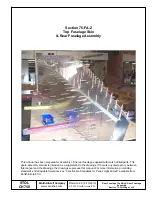
The drag chute can be used:
• When landing on wet or icy runway
• During any landing emergency involving
no-flap hydraulic or brake failure, or loss
of directional control
• During takeoff if the decision is made to
abort
Do not deploy the drag chute under the
following conditions:
• In flight
• If the nose gear is not on the ground
• When the indicated airspeed is above
150 knots
• With thrust reversers deployed
If chute deployment occurs above 150
KIAS or if jettison or failure occurs
above 100 KIAS, the drag chute
system and adjacent structure in the
vicinity of the tailcone access door
must be thoroughly inspected for
damage before the next flight.
PREFLIGHT
The following procedures may be accomplished
during the preflight inspection to check the drag
chute for proper installation:
• Open the tailcone access door.
• Pull the chute deploy handle in the
cockpit to full extension. Observe that
both handle grip safeties must be
depressed to pull the handle. Also note
that the chute riser attachment hook locks
and that the control mechanism crank and
ring function.
• Return the chute deploy handle to the
stowed (down) position.
• Ensure that the riser attaching loop is inserted
in the riser attachment hook and that the
hook is unlocked; ensure that the riser passes
through the loop on the riser keeper.
• Check chute riser for proper routing and
stowage as the tailcone access door is
closed.
OPERATION
As the nosewheel touches down, the copilot, on
the pilot’s command, deploys the drag chute by
squeezing the drag chute control handle and
pulling it up to its full extension (a pull force of
approximately 40 pounds may be required).
With the chute deployed, the pilot should keep
the airplane well clear of the runway and
taxiway lights, markers, and obstructions by
landing and taxiing on the upwind side. Taxiing
downwind should always be avoided.
NOTE
The drag chute trails approximately 37
feet behind the airplane. If the airplane
is taxiing downwind with a deployed
drag chute, the chute may overtake and
become entangled with the airplane.
The drag chute can be jettisoned after
deployment at any time. Normally, the pilot
heads the airplane into the wind as much as
possible to jettison the chute after the airplane
clears the runway. The copilot jettisons the drag
chute by squeezing the control handle grip
safeties and pushing the handle down to the
stowed position to release the chute. If the chute
has collapsed prior to jettisoning, the chute riser
must be pulled free after stowing the handle.
Because the possibility always exists that
jettisoning the chute might be required during
the landing roll, any planned deployment should
be coordinated with the control tower.
CAUTION
17-11
FOR TRAINING PURPOSES ONLY
LEARJET 20 SERIES PILOT TRAINING MANUAL
FlightSafety
international













































